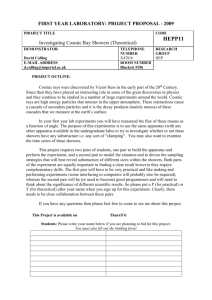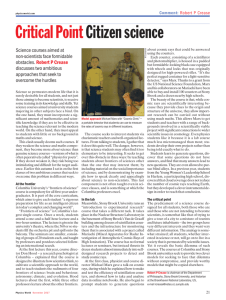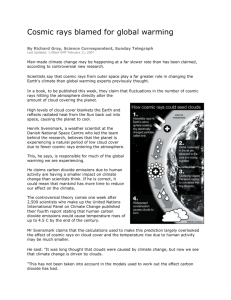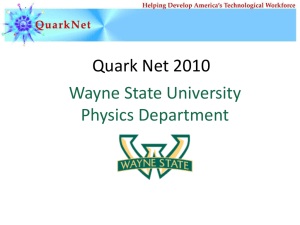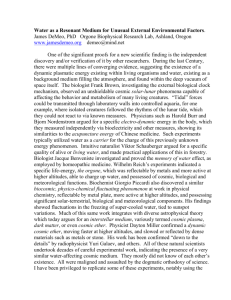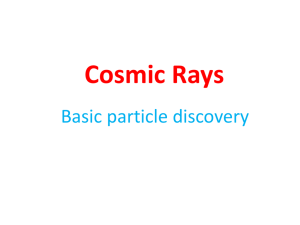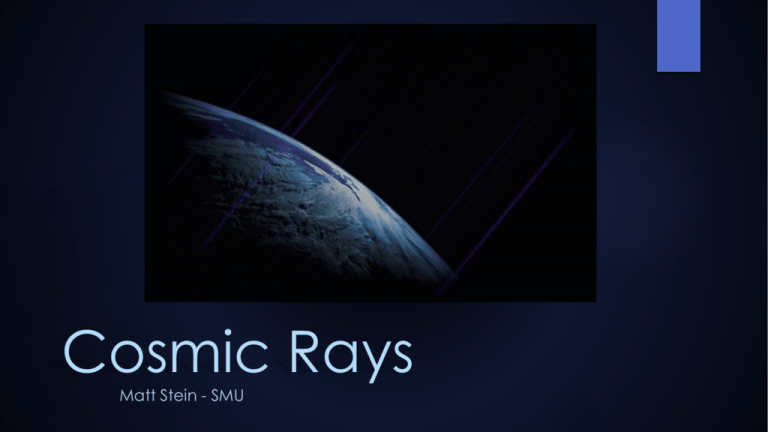
Cosmic Rays
Matt Stein - SMU
A long, long time ago…
1785: France
Charles Coulomb shows that
charged metallic bodies gradually
lose charge when placed in air
There will be conflicting opinions
on this claim, and its causes, for
the next ~100 years
In 1895, J.J. Thompson would
speak on “ions” in the atmosphere
Charles-Augustin de Coulomb
Why is the atmosphere ionized?
Radium in the Earth
Tests conducted overseas by Arthur
S. Eve, 1907
1901: Charles Thomson Rees Wilson
conducted experiments in deep
tunnels and caves
Found no decrease in ionization no
matter how much rock was
overhead
“It is unlikely, therefore, that the
ionization is due to radiation which
has traversed our atmosphere; it
seems to be a property of the air
itself.”
1909 – Theodor Wulf
Ionization at different heights
Theorized that if Earth were the
source of radiation, it should
quickly diminish with increasing
height
Took measurements from the base
and top of the Eifel Tower (~300m)
Recorded 6 ions per cc per
second at ground level, and 3.5
ions per cc per second on top
Expected to find only a few
percent of the ionization at the
top
The Gold-leaf Electroscope
Charge is applied to metallic wires
The static charge causes repulsion
between the wires and they
spread to form a “v” shape
Separation between the wires is
measured and total charge on
wires can be determined
August 7, 1912 – Victor F. Hess
Most decisive results starting
coming in by the 7th flight
Took off near Aussig, Austria and
flight lasted 6 hours
Balloon elevation ~ 16,400ft (5 km)
Conclusively correlated increasing
radiation with increasing altitude
Confirmation by Werner Kolhorster
The Millikan Debacle
Extraterrestrial origin of cosmic rays
was difficult for some to believe
Robert Millikan would work for
years in an attempt to disprove
Hess’ claims
Conducted experiments in San
Antonio, Pasadena, at Mt.
Whitney, and Pikes Peak
“The results then… constitute
definite proof that there exists no
radiation of cosmic origin having
such characteristics as we had
assumed.”
1925 – Lake Muir and Arrowhead Lake
Submerged
electroscopes to depths
as deep as 20m
Readings decreased
steadily to 15m
Atmosphere has
absorbing power of 7m
of water
Radiation levels off at
15m at Lake Muir and
does not decrease
further
Millikan confirms that this
radiation definitely
originates from outside
the Earth’s atmosphere
“Cosmic Rays”
It is Millikan who named this
radiation “Cosmic Rays”
After his 1923 Nobel Prize, he is
already the most respected
physicist in America
The New York Times names this
radiation “Millikan Rays” and
claims Millikan “discovered” them
What are cosmic rays?
A large variety of particles
including:
Electrons
Positrons
Protons
Muons
Other nuclei like carbon, oxygen,
neon, magnesium, silicon, iron,
nickel, and more.
Gamma rays (~0.1%)
Can be split into “Primary” and
“Secondary” rays
Primary and Secondary Cosmic Rays
Primary rays are the first to interact
with Earth’s atmosphere
They collide with air molecules
and create an “air shower” of
secondary particles
Can even convert Nitrogen into
Carbon-14
Generally characterized by
extremely high energies
Lower energies appear to be
more abundant
Typical energies between 107 and
1020 eV
Compare to LHC ~1013 eV, cosmic
rays can be up to 1 million times
more energetic
GZK Limit: Greisen–Zatsepin–
Kuzmin limit
Due to interaction with CMB,
theorized upper limit on energy
from “distant” cosmic rays is
1018 eV
(“Distant” meaning > 160 million
light-years)
How do we detect cosmic rays?
High energy cosmic rays can be
detected from their air showers
Air Shower Arrays are created to
detect particles and their
direction
In general, there are more
particles in the center of the air
shower
Scintillator detectors and water
Cherenkov detectors are used on
Earth
Scintillator Detector
Water Cherenkov Detector
Tibet Air Shower Experiment
Effective area of 36,900 m2
Comprised of 533 plastic
scintillation counters
Finds 1700 events/sec
Detects only secondary particles
Alpha Magnetic Spectrometer
Capable of detecting primary
cosmic rays
5 detectors onboard
Recent AMS Results
Positron fraction is higher than
previously assumed
Two popular theories:
1. Positrons generated by pulsars
2. Positrons are generated by dark
matter collisions
Further data collection up to 1TeV is
needed to test
There’s an app for that!
DECO: The Distributed Electronic
Cosmic-ray Observatory
Detects muons that interact with
the camera’s sensor
Muons come from the upper
atmosphere at 100 mouns/m2 /sec
http://wipac.wisc.edu/learn
Sources of Cosmic Rays
This is still a highly contested issue
Gamma rays travel in “straight” lines
and might point close to their source
(Particle 2)
However, most cosmic rays are
charged particles, and are subject to
having trajectories bent by magnetic
fields
Measuring trajectory may not, in fact,
reveal the original source (Particle 1)
Higher energy particles should be
deflected less, and would be more
reliable for measuring origin
But these are very rare: a cosmic ray
with energy ~1020 eV hits a square km
on Earth once per century!
Pierre Auger Observatory
Detection area of 3,000 km2
Located near the Andes
mountains in Argentina
Elevation ~4600ft
Blue dots (very hard to see) represent evenly distributed sources of lower
energy cosmic rays (less than 1018 eV)
Red dots represent higher energy sources
Black crosses indicated AGN
1 EeV = 1018 eV
Supernovae as sources
Shock front and magnetic field of
supernovae can accelerate
protons to cosmic ray energies
Upper limit for this, as proton will
escape at some minimum energy
Recently confirmed (Science,
2013) by examining pion-decay
gamma rays
Fermi Large Area Telescope
aboard the Fermi Gamma-ray
Space Telescope looked at
cosmic rays with energies ~109 eV
Cosmic Rays
First significant finding came in 1912 from
Hess’ balloon flight
Cosmic rays are a variety of very high
energy particles; the highest known to
exist
Air showers form when primary cosmic rays
interact with the upper atmosphere
Detecting these primary particles can be
done in space, as in the case of the AMS
Charged particles are difficult to
determine the source unless at the very
highest energy levels
All cosmic rays probably originate within
~160,000 light years
Sources are supernovae for low energy
cosmic rays, and AGN for high energy
cosmic rays
Resources
Abraham, J., et al. "Correlation of the Highest-Energy Cosmic Rays with Nearby
Extragalactic Objects." Science 318.5852 (2007): 938-43.
Ackermann, M. et al. "Detection of the Characteristic Pion-Decay Signature in Supernova
Remnants." Science 339.6121 (2013): 807-11.
Amenomori, M., et al. "Tibet Air Shower Array: Results and Future Plan." Journal of Physics:
Conference Series 120.6 (2008): 062024.
Bauleo, Pablo M., and Julio Rodríguez Martino. "The Dawn of the Particle Astronomy Era in
Ultra-high-energy Cosmic Rays." Nature 458.7240 (2009): 847-51.
Carroll, Bradley W., and Dale A. Ostlie. An Introduction to Modern Astrophysics. 2nd ed. San
Francisco: Pearson Addison-Wesley, 2007. Print.
Cronin, James W., Thomas K. Gaisser, and Simon P. Swordy. "Cosmic Rays at the Energy
Frontier." Scientific American 276.1 (1997): 44-49.
Griffiths, David J. Introduction to Elementary Particles. 2nd ed. Weinheim: Wiley-VCH, 2008.
Print.
Matthiae, Giorgio. "The Cosmic Ray Energy Spectrum as Measured Using the Pierre Auger
Observatory." New Journal of Physics 12.7 (2010): 075009.
Xu, Qiaozhen. "The Early History of Cosmic Ray Research." American Journal of Physics 55.1
(1987): 23.
Sun Spots and the Maunder
Minimum
Cosmic rays that are charged
particles interact with the Sun’s
magnetic field
Sun spots can have large affect
on the overall magnetic field
There is an anticorrelation
between sun spot activity and
cosmic ray interaction frequency
in Earth’s atmosphere
Sun Spots and the Maunder
Minimum
Carbon-14 is created from cosmic
ray interaction with Nitrogen
Can be absorbed by plant life as
CO2
Carbon dating trees shows a
correlation between solar activity
and Carbon-14

